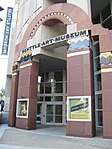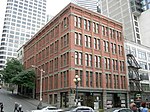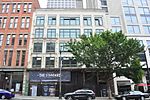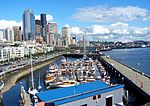The Schoenfeld Building, also known as the Standard Block, the Struve Building and the Meves Building, is a historic commercial building located at 1012 1st Avenue in downtown Seattle, Washington. Originally built in 1891 by land real estate and interurban developer Fred E. Sander, it has been used for retail, light manufacturing, and office space. It was expanded and remodeled to its current appearance in the late 1890s by one of its most notable tenants, Louis Schoenfeld, to house his rapidly expanding Standard Furniture Company which in less than a decade would outgrow this and a now-demolished neighboring building and result in the construction of the Broadacres Building at 2nd and Pine streets in 1907.
Owned from 1896 onward by the Struve family and later restaurateur A.J. Meves, for the entire second half of the 20th century the building was owned by the Polishuk family, pawnbrokers who operated Central Loan, the pawn shop seen in the 1974 John Wayne film McQ, for many years. The building was sold to the Wehl family after Nettie Polishuk's death in 2000 and they began gradually modernizing the building. Central Loan continued to operate into the late 2000s, and its closure was seen as the end of an era in a quickly gentrifying city.Designated a Seattle City landmark in 2014 as the Schoenfeld Building but officially known as The Standard, the building underwent a complete renovation and seismic retrofit in 2015. A 6th floor penthouse, not visible from the street, was added among other upgrades for prospective office tenants and the building remains fully occupied to the current day.












